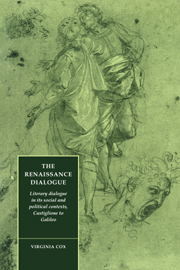 The Renaissance Dialogue
The Renaissance Dialogue Published online by Cambridge University Press: 05 December 2011
… to deliver a System in conversation scarcely appears natural
David Hume, Dialogues concerning Natural Religion (1779)One of the formal developments in the dialogue mentioned in the previous chapter deserves a more thorough examination than it was practicable to give it there. In contrast with the programmatically ‘disordered’ dialogue of Castiglione's era, the dialogue of the late sixteenth century shows an increasing preoccupation with system, method and order. Word like ‘ordine’ and ‘metodo’ recur frequently and anxiously in authors' prefaces and interlocutors' compliments: dim reflections of the mighty controversy which, as Francis Bacon rather discreetly puts it, had been ‘moved’ concerning the ‘method of tradition’ in his time. The present chapter will chart this intrusion of method into the dialogue, and, in doing so, will seek to bring to light the underlying reasons for the genre's decline.
The search for the philosopher's stone of ‘method’ had occupied Renaissance scientists and dialecticians since Agricola and, in the absence of any universally acknowledged directive from the ancients, it had spawned a vast and bewildering series of solutions. In the dialogues I am considering, however, it would be vain to look for reflections of the more sophisticated developments in the field, and one suspects that the methodology of most writers owed as much to imitation of Plato's practice as to reference to his precepts or those of contemporary writers on logic.
To save this book to your Kindle, first ensure [email protected] is added to your Approved Personal Document E-mail List under your Personal Document Settings on the Manage Your Content and Devices page of your Amazon account. Then enter the ‘name’ part of your Kindle email address below. Find out more about saving to your Kindle.
Note you can select to save to either the @free.kindle.com or @kindle.com variations. ‘@free.kindle.com’ emails are free but can only be saved to your device when it is connected to wi-fi. ‘@kindle.com’ emails can be delivered even when you are not connected to wi-fi, but note that service fees apply.
Find out more about the Kindle Personal Document Service.
To save content items to your account, please confirm that you agree to abide by our usage policies. If this is the first time you use this feature, you will be asked to authorise Cambridge Core to connect with your account. Find out more about saving content to Dropbox.
To save content items to your account, please confirm that you agree to abide by our usage policies. If this is the first time you use this feature, you will be asked to authorise Cambridge Core to connect with your account. Find out more about saving content to Google Drive.